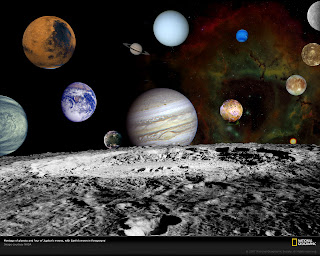Somehow my homeschool classroom has become centered around science. It must be what interests my eldest student most (the youngest being a mere 10 weeks old), since she's managed to finagle all sorts of unit studies out of me (how do strawberries grow? Why do trees lose their leaves? I want to learn about being an astronaut! I want to be a doctor... etc.). You can learn reading, writing and arithmetic using just about any subject, but it's easier to create interest around those things when the subject is fun for the student. Recently we've been learning about space, mostly because I wanted to teach about calendars and time, so we had to understand how time works, first. I divided the awesomely vast subject into a few days (we could have taken a whole year):
1) Planet Earth- from the inside out- rocks and minerals, continents, basic geography, etc. Very basic overview. We reviewed our volcano study from earlier this summer, too.
2) The planets and our solar system- names of the planets, the name origin, how planets orbit and spin, etc, time and weight, gravity, etc.
3) Stars and other bodies- primary focus on constellations and space exploration.
NASA is an amazing resource online, but not the only one, that shows actual video and interactive activities about space exploration and our solar system. A simple google search yields many great sites for kids.
Of course, we read lots of books at our house. So here are three of my favorite storytelling books, one for each day above, about space. Every subject in school deserves good stories!
1. Whole World This is a Barefoot Books rendition of the old classic song. The focus here is on stewardship and also on the various environments of our planet. The song is catchy, of course, and the illustrations quirky and fun. It opens the door to all sorts of discussion about what our planet is all about and how we can practice planetary stewardship. There is also a workbook to accompany the book, but it's a little advanced for my darling student.
2. Star Seeker is a Barefoot Books title that truly is a journey- beautiful illustrations of the planets and a lyrical story that keeps the imagination going long after the book has ended. The end notes have tons of scientific data about our solar system and beyond, successfully linking story to science. Hooray!
3. Zoo in the Sky is a great book about the constellations. My daughter used this book to develop her own constellation pictures, which is actually quite easy for a four-year-old since they can be fairly abstract. Again, lots of info at the back to blend science and story. This book has great illustrations showing actual star placement within the constellations.
Of course we read lots of non- fiction books, too, about astronauts, planets and space. I can't wait to revisit this topic when we come back to it in a few years! And a year is 365 days, a day is 24 hours, an hour is 60 minutes, a minute is 60 seconds, etc... what better way to learn about time than through stories? Happy storytelling!




No comments:
Post a Comment